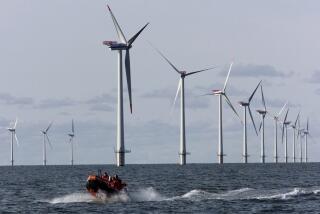Windfall? No, but Savings Ahead
- Share via
DENVER — Tom DeMoulin was not expecting a bargain when he began buying his electricity from wind farms in the late 1990s. In fact, the community college instructor paid an extra $5 a month to his local utility to strike a blow against the coal- and gas-fired power plants that spew pollution across the Southwest.
But starting next month, DeMoulin’s conscience-driven decision will save him money. Because of skyrocketing natural gas and coal prices, Colorado’s 29,000 wind-energy customers for the first time will pay less than Xcel Energy’s 1.3 million customers who use conventionally generated power.
After the savings was announced Wednesday, Xcel signed up as many customers for its Windsource program in one day as it normally does in two months. The surge in interest is the latest example of rising energy costs making wind power increasingly attractive to consumers.
In Edmond, Okla., wind-power users now pay less than other customers. The wind program in Austin, Texas, known as GreenChoice, will cost less than conventional power beginning in January. Makers of wind turbines report being sold out until 2008.
“It’s a pretty momentous occasion for those of us in the renewable energy business,” said Dan Lieberman of the Center for Resource Solutions in San Francisco, referring to the Colorado situation. “It’s been the lean years, but now it’s the fat years.”
The price of natural gas hadtripled in the last three years, even before hurricanes Katrina and Rita pushed prices even higher. The price of coal, the other fossil fuel used to generate electricity, has also shot up. Many energy experts see prices remaining high, and say the new savings to wind customers suggest a fundamental shift.
“Is it possibly a tipping point? Absolutely,” said Ryan H. Wiser, a scientist at Lawrence Berkeley National Laboratory. “We have a circumstance where wind-power generation looks pretty competitive.”
There are still many obstacles to wind power. Because wind farms need vast open space, they are often situated far from the areas that consume their power, with long-distance transmission driving up costs. In addition, they do not generate power continuously.
“We’re not going to see 100% wind for two reasons,” said Severin Borenstein, director of the UC Energy Institute in Berkeley. “There are limited areas where you can install wind economically. And the wind doesn’t blow all the time.”
Still, he said, the recent run-ups in natural gas prices are a big factor. “That has really changed the economics,” Borenstein said.
Wiser said he had conducted a study of 12 major utilities showing that wind was increasingly being added to the generation mix.
The changes in Colorado and Austin, home to the two largest green power programs in the nation, are especially significant, analysts say.
The two utilities are among the few that pass savings from green power on to their customers. Most utilities charge customers who use environmentally friendly power the same base rate they charge those who use gas- or coal-fueled electricity, plus a premium, Lieberman said.
Wind power’s cost-effectiveness varies by region. Xcel Energy’s Minnesota wind program, for example, is still more expensive than its conventional program, because much of its electricity is generated by nuclear power, which has not seen price hikes comparable to those of natural gas and coal.
The Los Angeles Department of Water and Power allows residential customers to purchase a maximum of 20% of their power from environmentally friendly sources, which also include solar energy. Because the DWP’s conventionally generated electricity relies on hydroelectric and nuclear sources, along with coal and gas, it remains less expensive than green power, spokeswoman Kim Hughes said.
The DWP gets 5% of its electricity from environmentally friendly sources and plans to boost that to 20% by 2010. Private California utilities must meet that goal by 2017, and Gov. Arnold Schwarzenegger is contemplating raising the percentage. Hughes said that was why green power would make more economic sense in the future.
“As you see lots of different utilities moving to renewables, I think that will spur innovation that will bring the cost down,” Hughes said.
Advocates say the cost stability of wind power, compared with the fluctuations of coal and gas, is one of its best attributes.
In Austin, the utility offers its wind customers a guaranteed rate for 10 years, and 400 businesses have taken that deal, including a branch of Sunnyvale, Calif.-based Advanced Micro Devices, which signed up two weeks ago. “We thought it was a really good business decision,” said Lee Reznicek, the company’s environmental health and safety manager. The move is projected to save $4 million over 10 years, Reznicek said, adding that the company is happy to help the environment as well.
In Colorado, 45% of Xcel’s power comes from coal-fired plants and 48% from natural gas. Socked with high fuel costs, the utility will raise rates by $116 million for its conventional customers starting in November. That’s what will enable Windsource customers to save an average of $10 per month.
Rick Gilliam is one of those customers. A senior energy policy advisor for Boulder-based Western Resource Advocates, Gilliam had held off signing up for Windsource because he resented paying more for a resource that he argued should be cheaper. But he registered in August and is happy now.
“I’m certainly looking forward to that rebate,” Gilliam said, “so I can install a solar system in my house.”
More to Read
Inside the business of entertainment
The Wide Shot brings you news, analysis and insights on everything from streaming wars to production — and what it all means for the future.
You may occasionally receive promotional content from the Los Angeles Times.










